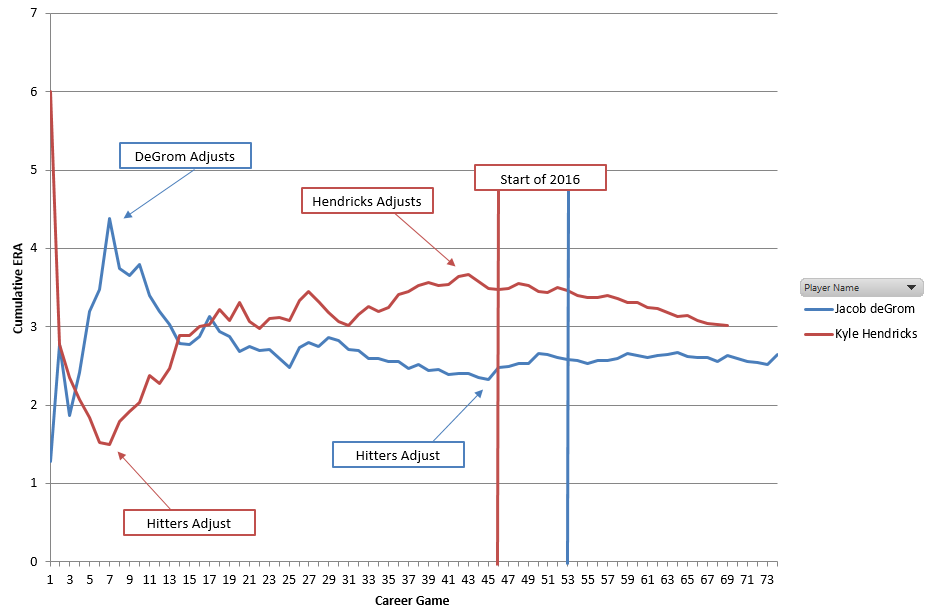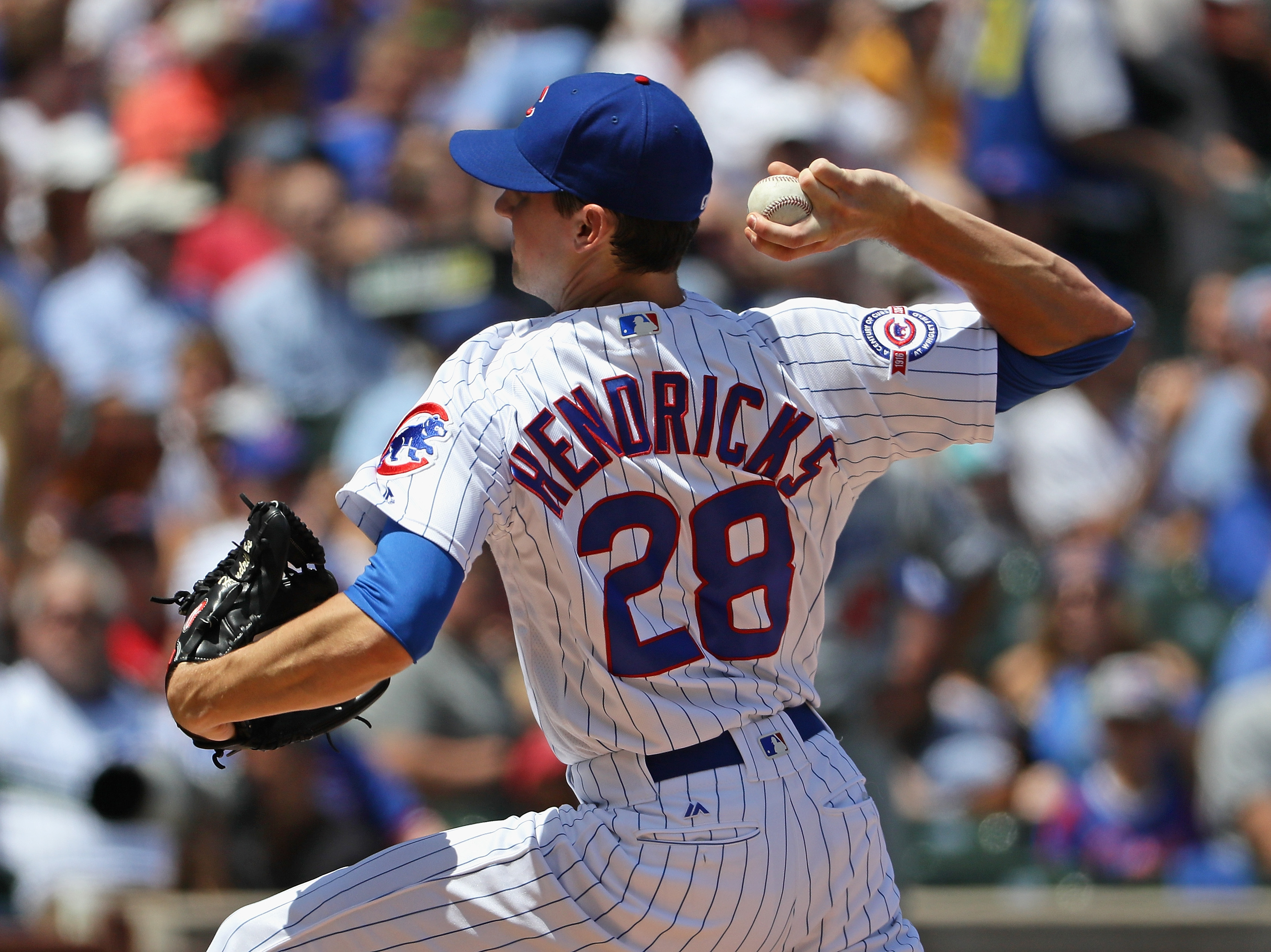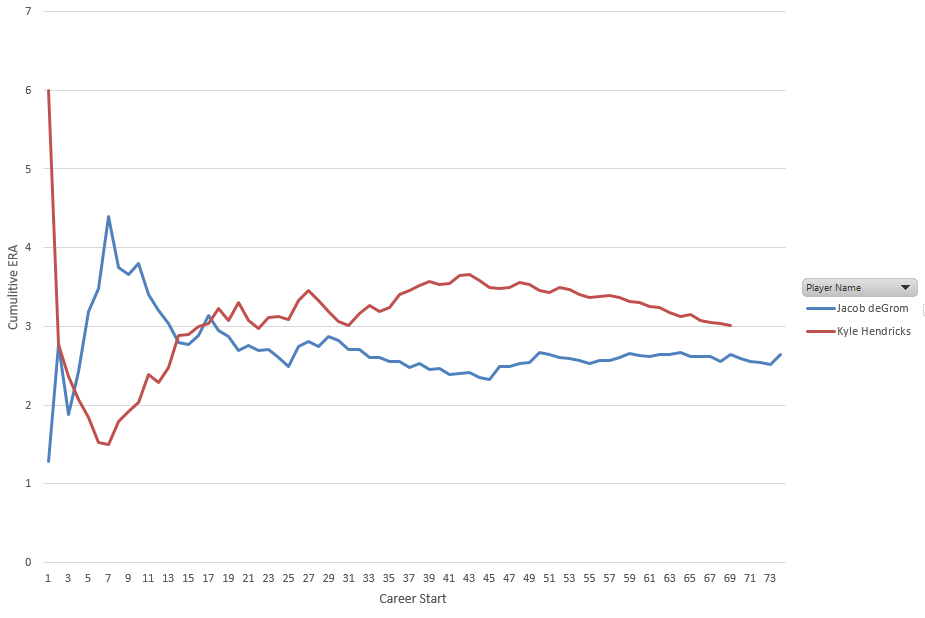I have long been a fan of Chicago Cubs invisible Ace, Kyle Hendricks. I wrote about him last October, in an article that looks prescient today. From that piece:
“Kyle Hendricks has yet to make that incline in ERA look like a peak, instead of a plateau. His plateau is still quite good (career 3.49 ERA), but if he is able to make an adjustment to the hitters’ adjustment, he will make that next leap. Jacob deGrom has gotten better by gaining an extra 1.5 mph on his fastball. That’s one way to adjust to hitters at the big league level. Kyle Hendricks simply needs to make his next adjustment if he wants to take another step toward the upper echelons of the pitching hierarchy.”
I even wrote before this year that Hendricks was one of the top guys that you’ve never heard of, and I’ve been on his bandwagon from the moment he was called up to the Bigs. I can’t seem to find the proof of my fandom dating back to 2014 other than this tweet mentioning his ERA in July of that– rookie– year, but the 26 year old is now making me look like a genius. He’s put together a league-leading 2.16 ERA so far– and he has yet to make this decline in ERA look like a peak vs. a plateau.
But this article isn’t about how right I was on Kyle Hendricks. No, it’s going to explore more fully that idea of “adjusting to adjustments” that was at the core of my first Hendricks piece.
The most basic tenet here is that hitters and pitchers are constantly adjusting to each other. Maybe the scouting report gets around on a pitcher; maybe an injury saps some velocity; maybe a new contract disrupts focus. Similarly for hitters: maybe teams begin to shift on them; maybe the fastball up and in gets exploited; maybe their youthful speed evaporates. No matter what, pitchers and hitters must adapt their approaches and reinvent themselves to be successful. The back and forth duel can best be characterized as adjustments, and then adjustments to those adjustments. At first the adjustments are large, but though they get smaller, they continue throughout a career. When someone can no longer adjust, it’s time to hang ’em up.
So, how are Jacob deGrom and Kyle Hendricks doing with those adjustments a year or so later? Let’s update the graph from that old post with this year’s starts included.
At first blush, what do we see? Jacob deGrom is better than Kyle Hendricks. Ok, fair enough. We knew that already. But we also see that somewhere around start 43, both pitchers hit a bit of a local extreme. For Hendricks, his career ERA has mostly gone down since start 43. For deGrom, his ERA has been rising since career start 45. It sure looks like Hendricks will have the better career ERA before too long.
The fun part here – the part that supports this “adjustment theory” – is that the two have already flip flopped a few times as they settled into their big league uniforms. Hendricks had the better of deGrom through about 15 games started and deGrom went on an incredible stretch that seems to be coming to close. Take a look at the annotated graph so that we’re all on the same page.
 This is fun because it appears that the two are exactly offsynced. Maybe that’s a reflection of being 18 months apart in age. Maybe it’s more a reflection of their relationships with hitters. In deGrom’s case, it sure seems like his ability to get major leaguers out depends on his fastball velocity. But really, that “hitter adjustment” for deGrom is not much. He’s posted a sub-3.00 ERA in each of his seasons in the big leagues.
This is fun because it appears that the two are exactly offsynced. Maybe that’s a reflection of being 18 months apart in age. Maybe it’s more a reflection of their relationships with hitters. In deGrom’s case, it sure seems like his ability to get major leaguers out depends on his fastball velocity. But really, that “hitter adjustment” for deGrom is not much. He’s posted a sub-3.00 ERA in each of his seasons in the big leagues.
For Hendricks, the career arc is more apparent. Something happened towards the end of last season that has led to the success this year. I dove into all the numbers and didn’t find much. If anything, he’s pitched slightly worse on the whole this year. His strikeout rate is down, walk rate slightly up. He’s throwing slightly fewer strikes and his pitches aren’t moving quite as much. All of that is clearly the harsh way of phrasing it. Hendricks does have a 2.16 ERA after all.
The one theory I have for you: defense. Where Jacob deGrom learned to throw about 1.5 miles per hour harder after arriving in the bigs, Kyle Hendricks learned to have a better defensive infield behind him. Starlin Castro was moved off of the shortstop position in Chicago mid-August of last year. Hendricks’ big adjustment came in mid-September.
There’s no way to locate any one thing that creates the up and down rhythm of performance fluctuations, but with these two pitchers, we can clearly see their performance fluctuate over their first 2.5 years of big league starts. It should be fun to see how their careers play out. Neither was a top 100 prospect, but now both are about to have career ERAs below 3.00– even if their recent performance is trending in mostly opposite directions.
-Sean Morash






